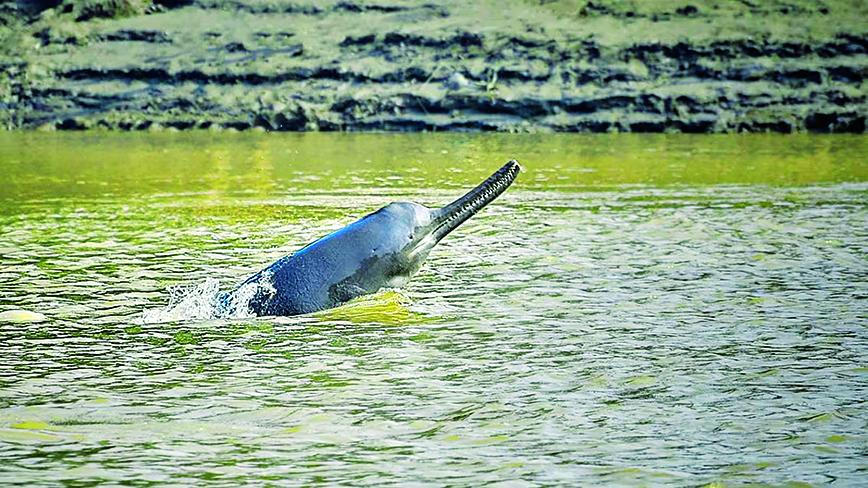
VENKATESH DUTTA
SANCTUARIES inside rivers? Yes. There are several stretches of rivers that have been declared protected areas under the Wildlife Protection Act, 1972. These river stretches are special in many ways — they are known to protect and shelter many iconic species such as dolphins, gharials, otters and turtles.
Chambal, once infamous for its notorious bandits, has undergone a remarkable transformation and now stands as a sanctuary for the endangered gharials. The National Chambal Sanctuary, also known as the National Chambal Gharial Wildlife Sanctuary, is a vast area that covers 5,400 sq. km. The river meanders through a labyrinth of ravines and hills within the sanctuary. It extends over three states, namely, Uttar Pradesh, Madhya Pradesh and Rajasthan. The sanctuary is known to provide a habitat for the distinct aquatic life that thrives in the Chambal river, particularly the critically endangered gharial.
The river is also home to the endangered Gangetic river dolphin and red-crowned roof turtles. Gangetic river dolphins are classified under Schedule I of the Indian Wildlife (Protection) Act and have been declared an endangered species by the International Union for Conservation of Nature (IUCN). Currently, the Bah range of the Chambal Sanctuary has 24 dolphins, while the Etawah range is home to 147 dolphins. While sightings of these dolphins are rare in these waters, they can be spotted occasionally in the deeper reaches of the sanctuary. Apart from rich riverine diversity, the sanctuary boasts more than 300 species of resident and migratory birds, with several migratory species from Siberia contributing to its diverse bird population.
Two stretches of the Ganga have been declared as sanctuaries. The first is the 82-km stretch between Garhmukteshwar in Hapur and Narora in Bulandshahr district. It was declared a Ramsar site (wetland of international importance) in 2005. The Ramsar Committee designates potential wetlands worldwide as Ramsar sites following an assessment of their ecological importance and significance. Approximately 63 km of the river stretch lies within Bulandshahr district, while the remaining portions extend into Hapur, Amroha, and Sambhal districts.
This river stretch is currently inhabited by 22 Gangetic dolphins. They have been declared the national aquatic animal of India. However, this stretch lacks a conducive environment for breeding and increasing their population. The discharge of partially treated or untreated sewage from adjoining towns as well as effluents from sugar mills, paper mills, and other industries located near the river poses a significant threat to aquatic animals. Additionally, the run-off carrying pesticides from riverbed farming and illegal fishing activities also needs to be addressed to ensure effective protection of the endangered dolphins.
The second is the 60-km stretch of the Ganga extending from Sultanganj to Kahalgaon within Bhagalpur district of Bihar. This stretch was officially designated the Vikramshila Gangetic Dolphin Sanctuary (VGDS) in 1991. As a riverine habitat, the boundary and expanse of the sanctuary continually change due to flooding and the evolving geomorphology of the Ganga.
Almost half of this stretch has many sandbars which are excellent breeding grounds for birds. There are several river islands known as dyara which are also the nesting sites of turtles. Regular conflicts among local residents arise due to disputes over land ownership, attributed to the changing course of the river and the disappearance and reappearance of river islands. Dolphins have become more visible in the sanctuary due to reduced human activity on the Ganga. Currently, there are around 200 dolphins in this stretch of the Ganga.
Gangetic river dolphins are blind and depend on echoes to navigate their environment and find prey in the water. They rely on echolocation, where sound serves as their primary sense. Using echolocation, they navigate, hunt for food, avoid threats, find mates, reproduce, and nurture their young. The National Waterway-1, connecting Haldia to Varanasi, would pass through the Vikramshila Sanctuary. The noise and vibrations from the large cargo vessels may disturb the breeding potential of these elusive dolphins. Sounds are indeed louder in water. This is because water is denser than air, causing sound waves to travel faster and with more energy in water compared to air.
There is also one case of a river sanctuary being denotified. Varanasi’s stretch of the Ganga, a seven-km stretch from Ramnagar Fort to the Malviya railroad bridge that was declared the only Turtle Wildlife Sanctuary in 1989 was denotified by the Uttar Pradesh government in preparation for a possible relocation to another stretch, the Allahabad-Mirzapur section of the Ganga. With National Waterway-1, Varanasi would serve as one of the major hubs for cargo transportation along the Ganga. Given their peaceful nature, turtles leave areas where such disturbances occur.
After the National Chambal Sanctuary on the Chambal river, the Gandak river in Bettiah, West Champaran district of Bihar, has emerged as the second successful breeding site for gharials in India. However, this stretch has still not been declared a sanctuary.
The expansive floodplains of the Ganga and its tributaries, interconnected lakes and ponds along its banks, as well as mud flats within the river, create a perfect habitat for numerous animals, birds and plants. Despite some of the stretches being declared protected sanctuaries, they continue to face ongoing challenges such as habitat degradation, pollution, and conflicts between humans and wildlife. Illegal sand mining poses a significant threat to the flora and fauna in certain sanctuary sections. Numerous dams and barriers also disrupt free movement of dolphins within the sanctuary.
Venkatesh Dutta is a Gomti River Waterkeeper and a professor of environmental sciences at Ambedkar University, Lucknow
Comments
Currently there are no Comments. Be first to write a comment!




